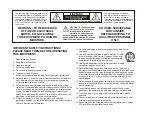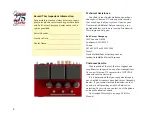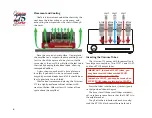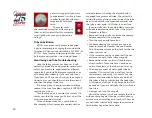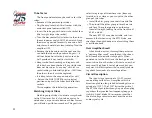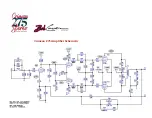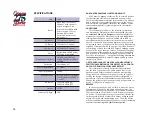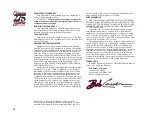
11
Tube Tester
The front panel meter may be used to test the
tubes.
• Remove all the power output tubes
• Plug the amp into the AC wall socket with the
main rear panel power switch OFF.
• Insert the tube you wish to test into socket four
(the far-right large tube socket).
• Turn the bias control fully clockwise, then turn
the main power switch ON. With a watch, time
the warm-up period for exactly one and a half
minutes and note the current reading. Turn the
amplifier OFF,
• Remove the tube and insert the next one. You
can hold the tube with your bare fingers — it
will not be too hot after only a minute and a
half, provided it was cool to start with.
• Keep track of each reading, and repeat until
all tubes have been checked. If any single tube
does not bias up or “runs away” with its cur-
rent climbing substantially higher, ≈200% than
the others, then it must be replaced.
• It is okay to turn the amp on and off at will.
• Return the BIAS CONTROL to its original
position and put all the tubes back into their
sockets.
This completes the tube testing operation.
Matching Output Tubes
Matching output tubes is not necessary, thanks
to the DC restorer. But it’s fun to do anyway. As
noted above, as you wrote down each bias current,
you will end up with four numbers. The goal is to
select two groups of two whose sum (from any
two tubes) is as close as you can get to the other
group of two tubes.
• Install the first group in sockets One and Two.
• Then install the other group into sockets two
and four. The socket positions on the amp,
from left to right, looking from the front are: #1,
#2, #3, and #4.
The new KT120’s are quite variable, and I rec-
ommend that when using the KT120 tube, one
should go through the exercise of matching them
as outlined above.
New Amplifier Smell
Like a brand new car, this amplifier possesses
a “new amplifier smell,” even though it has been
built from both new and vintage parts. When
powered up for the first time, the fresh paint and
recent skin oils on the tubes will create a new, hot
amp smell. Bob finds it sort of pleasant, but you
may not. It will dissipate with use, usually requir-
ing about four weeks of normal operation.
Circuit Description
The input stage consists of a 12AX7 current
sourced long-tailed class A amplifier, which is
direct coupled to a long-tailed balanced pair com-
prised of a 12AT7. The 12AT7 drives the grids of
the KT120 output tubes through a pair of coupling
capacitors that provide low frequency loop-gain
stability. A dual-diode DC restorer ensures that
the bias voltage remains correct over the entire
audio signal cycle.
Summary of Contents for 27813
Page 1: ...Operating Manual c02 15 19...


